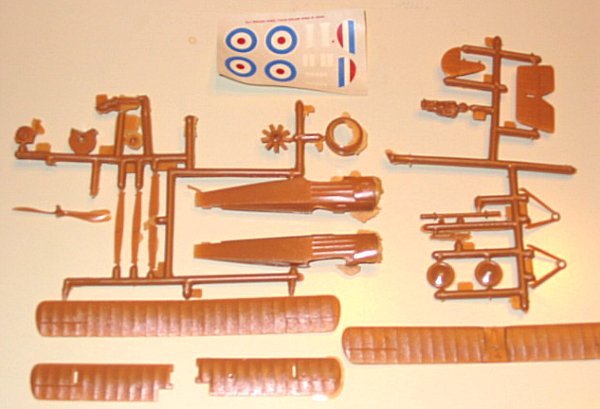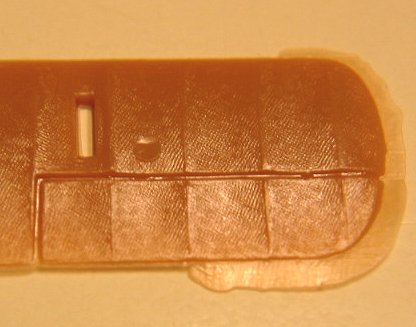
|
KIT: |
Revell 1/72 Sopwith Triplane |
|
KIT # |
H-654 |
|
PRICE: |
$ |
|
DECALS: |
Three aircraft |
|
REVIEWER: |
Bill Michaels |
|
NOTES: |
1966 boxing |

|
HISTORY |
The Sopwith Triplane entered service with the RNAS in June of 1916. Only about 150 of the aircraft were built, and the triplane was only used by the Naval squadrons. The aircraft was only in front-line service for about a year, when it was replaced by the Sopwith Camel. During that time, the aircraft racked up 87 enemy aircraft.
The most famous Triplane squadron was “B flight of Naval 10—the “Black Flight”. The aircraft of the flight were all finished with the nose of the aircraft painted black. Canadian Ace Raymond Collishaw and his mates flew aircraft named “Black Maria”, “Black Death”, Black Prince, etc.
Perhaps the Sopwith Triplane’s greatest legacy is that its success is reputed to have inspired the Germans to develop their own triplane. The winner of that competition was the infamous Fokker Triplane, the Dr.1.
|
THE KIT |

This kit was available in the late 1960s and into the 1970s, I believe. I’ve owned and built a few of them over the years, and have never seen any boxings of the kit from the 1980s or later.
The kit used for this preview is the UK version, although it was released in the USA in basically the same way. This model includes markings for only one aircraft, Collishaw’s “Black Maria”. This one is a little unique in that it is molded in a medium brown plastic, instead of the usual dark green.
Revell also released this kit in the USA, in their “Collector’s Choice” series. Like the other aircraft in the series, that version of the tripe included parts and decals to build one of three different versions. You could build Collishaw’s and one other aircraft from the black flight, basically the same plane with different names under the cockpit.
The third option was also released in a separate box. This
was the prototype aircraft, which had a larger stab and was finished in doped
linen overall. I’ve seen one version of the kit which purported to be just of
the prototype, but it still included the smaller production stab on the sprues. 
The copy of the kit I’m using for this preview has more flash than is typically found on these models. As you can see in the picture, there is a fair amount of flash on the different parts. However, this should be easy to remove, and there are no signs of mold mis-alignment. Trailing edges seem to be pretty fine, too. The wings and fuselage suffer from somewhat overdone fabric detail, as was typical for kits from this era. You might want to consider a gentle sanding or just paint the model by brush to subdue the fabric effect, if it is overdone for your taste. The model has some sink marks on the parts that will need to be filled. Generally, they are on the underside of parts such as the flying surfaces.
There is a pilot figure included in the kit, but he is not one of Revell’s better efforts. He looks like he’s wearing a hooded parka instead of a flying helmet. The interior consists of a seat and nothing else.
My version included a display stand, but this is the only version I’ve owned that had it. (Maybe it is unique to the UK version—it does remind me of Airfix stands from the period.)
Triplanes were finished in the standard PC-10 over clear doped linen. My kit calls “khaki” over “tan”. Any decals you find in a kit from this vintage are going to be oild and thick, so replacements will be in order. Fortunately, there are a number of aftermarket decals for WW1 British aircraft, though none for the Triplane specifically. Still, it should be easy enough to find something that will fit.
This is not a full build review, but I have built the kit a couple of times in the past. I will pass on a couple of tips /warnings:
The molded on tailskid is very fragile, and easily broken or lost during construction. Do what you can to protect it while building the model.
Wing alignment can be tricky, and the middle and top wings are a lot harder to install than on a Fokker Triplane. The middle wing does not attach to the fuselage- it attached to the interplane struts and the cabanes. Keeping everything aligned while the glue dries can be a challenge—use a jig or something!
|
CONCLUSIONS |
Recommended for all but beginners. The tricky wing install may frustrate beginners, this is not a good choice for your first WW1 kit in 1/72. I haven’t compared the model to plans myself. However, this kit has been generally regarded by WW1 modelers as a good kit, accurate in shape, and suitable for further detailing.
For everyone else, though, this is one of Revell’s good WW1 kits in 1/72—it is a pity it hasn’t been re-released recently. Even so, you can find the kit on Ebay or from used dealers in the $5 to $15 range. At this price, it is still a good deal, unless Roden is planning to do one someday….! (I can dream, can’t I?)
Review kit courtesy of me and my wallet.
|
REFERENCES |
Sopwith Triplane Windsock Datafile #22, by J.M. Bruce; Albatros Publications; Berkhamsted, UK, 1990, 1995, 2000.
Sopwith Fighters in Action, Aircraft # 100, by Peter Cooksley; Squadron/Signal Publications, Carollton Texas; 1991
If you would like your product reviewed fairly and quickly by a site that has well over 175,000 visitors a month, please contact me or see other details in the Note to Contributors.